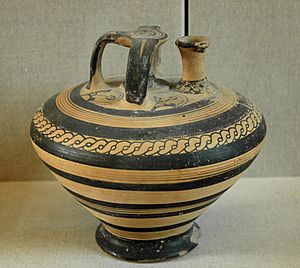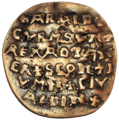Artifact (archaeology) facts for kids
- For other uses of artifact, including errors, see artifact (disambiguation).
An artifact is an object that was made or changed by humans. These can be tools, works of art, or anything else people created or used a long time ago.
In archaeology, which is the study of human history through digging up old things, an artifact is any object found that tells us about past cultures.
Examples of artifacts include stone tools, pottery (like old pots or jars), metal items (such as weapons), and things people wore, like buttons or jewelry. Even bones that show signs of being used or changed by humans are considered artifacts.
Things found by archaeologists that were made by nature, like seeds, animal bones, or rocks cracked by fire from an old hearth, are called ecofacts. They are different from artifacts because humans didn't make them, but they still tell us about the past environment or diet.
What are Artifacts?
Artifacts are super important for understanding how people lived in the past. They are like clues that archaeologists find. These clues can come from different places or situations:
- Burial Sites: Sometimes artifacts are found buried with a person, giving us hints about their beliefs or social status.
- Homes and Settlements: Many artifacts are found in places where people lived, like old houses or middens (ancient trash heaps). These show us what daily life was like.
- Special Offerings: Some artifacts were left as Votive offerings to gods or spirits.
- Hidden Treasures: Artifacts can also be found in Hoards, which are collections of valuable items hidden away, sometimes in places like old wells.
Artifacts are different from other things archaeologists find. For example, non-portable remains like hearths, roads, or old trenches are called "features." And as we learned, natural items like seeds or animal bones are called biofacts or ecofacts.
Sometimes, natural objects that humans moved but didn't change are called manuports. An example would be a seashell found far inland, moved there by a person.
It can sometimes be tricky to tell the difference between these things. For instance, a bone from an animal is an ecofact. But if that bone was carved into a tool, it becomes an artifact! Also, it can be hard to tell if a stone is a tool made by a human or just a naturally shaped rock that looks like a tool (called a geofact).
Images for kids
-
A Crusading Period spoon from 1017, found during an archaeological dig in Tursiannotko in Pirkkala, Finland.
-
The Curmsun Disc - Obverse side. This disc was found near Jomsborg and dates back to the 980s, possibly from the burial site of king Harald Bluetooth.
See also
 In Spanish: Artefacto arqueológico para niños
In Spanish: Artefacto arqueológico para niños





